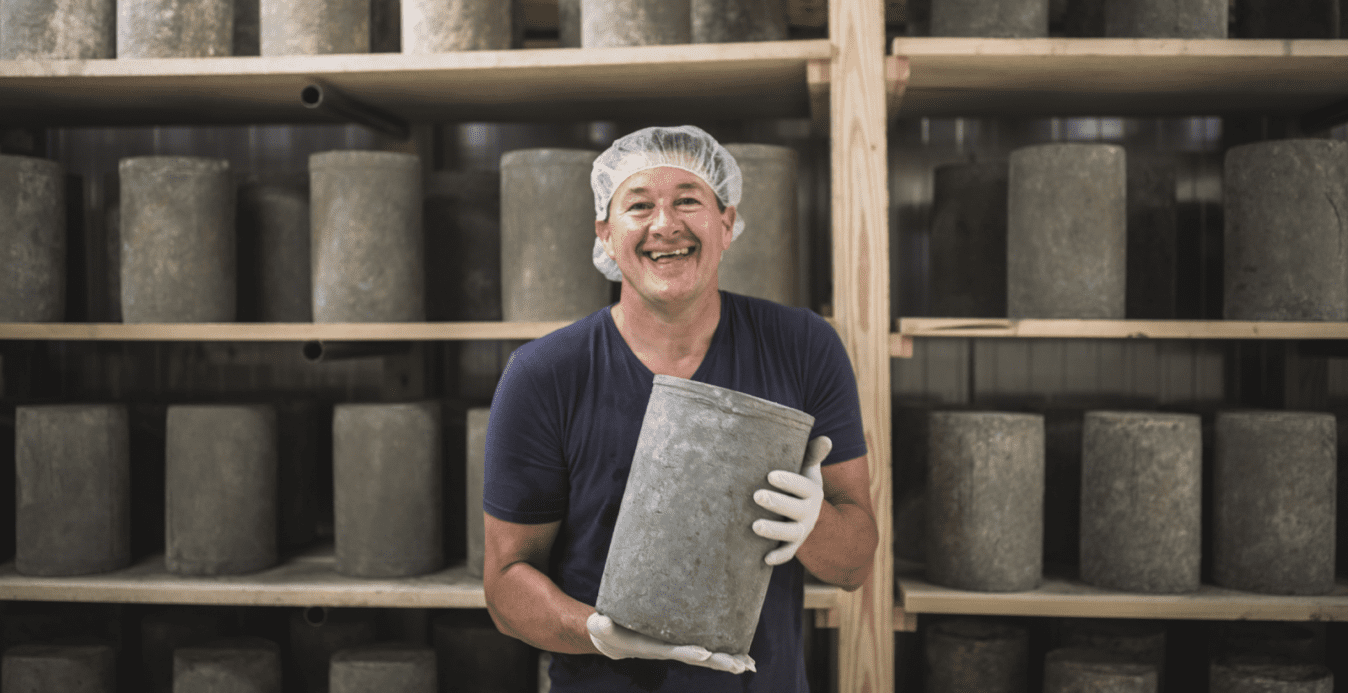From the U.S. Green Building Council
https://www.usgbc.org/articles/urban-stead-cheese-achieves-leed-silver-certification-usgbc-ohio
Urban Stead Cheese achieves LEED Silver certification (USGBC Ohio)
Alicia Blum, Mar 17, 2021
Learn how the local business sustainably cultivates “Cheddar for the Better.”

Owners Andrea and Scott Robbins of Urban Stead Cheese in their Cincinnati, Ohio shop.
Urban Stead Cheese recently achieved LEED Silver certification as the shop also celebrated three years of cheesemaking for the Cincinnati, Ohio, community. Owners Andrea and Scott Robbins were raised in families with generations of dedicated dairy farmers among them, and as their visions of cheesemaking were developing, having a sustainable farm-to-community relationship was critical. “Cheddar for the Better” has become their litmus test as decisions such as shop location and resourcing were made, and achieving LEED certification fell closely in line with their goals.
The LEED process began in the early stages of design: a renovation to maintain 58% of the existing structure of a building on the border of East Walnut Hills and Evanston. Eliminating the need for new construction and providing access to public transportation for employees, while also positioning themselves in the urban core, were all factors in selecting the location of Urban Stead Cheese. Additionally, they were able to divert 83% of construction waste from landfills.
Creative energy solutions
The cheese-making process requires a large amount of water, so earning the credit for 50% reduction of indoor water usage required unique strategies. Urban Stead installed water flow reduction devices on all indoor faucets and toilets throughout the building, including throughout the cheesemaking side of the business.
Another unique solution was achieved with the installation of a dry cooler on the roof. The cheesemaking process requires the heating and cooling of milk; Urban Stead Cheese maximizes efficiencies during this process through the use of a dry cooler. The dry cooler acts as a radiator, essentially dumping heat into the atmosphere versus requiring energy to power the cooling of the milk. Maximum efficiency for this system is obtained during the colder winter months, when there are the greatest air and water temperature differentials to enable more efficient cooling of the milk.

Head cheesemaker and co-owner Scott Robbins holds a truckle of Urban Stead’s Street Ched, their aged clothbound cheddar.
Alongside the shop’s many sustainable efforts are beehives. Keenly aware that the cows providing milk for cheesemaking eat food that must be pollinated by bees, Urban Stead Cheese has partnered with Queen City Pollinator Project to contribute to help increase the bee population.
Urban Stead Cheese also strives to replicate the natural farmstead reuse of whey from the production of cheese, utilizing waste in a useful manner while providing whey to a local farm for livestock feed. LEED educational materials now adorn the tasting room—appropriately displayed upon a cheese board—and Urban Stead Cheese looks forward to sharing their sustainable story with the community.
Tour information
In partnership with USGBC Ohio and The Sustainability Partnership of Cincinnati, David Smith, Solar Energy Solutions and Third Sun Solar, there was a free virtual tour of Urban Stead on April 10. Watch it here
- LEED v4 BD+C: New Construction
- Certification date: 10/21/2020
- Silver 50 (out of a possible 106 points)
- Integrative Process 1/1 (this one is not shown in the design)
- Sustainable Sites 0/10 points
- Location and Transportation 7/16 points (this one is not shown in the design)
- Water Efficiency 10/11 points
- Energy and Atmosphere 13/33 points
- Materials and Resources 7/13 points
- Indoor Environmental Quality 6/16 points
- Innovation 6/6 points
- This items was not pursued in the end: “1.5% or less of exterior lighting emitted above horizontal
- “59.4% Reduction of Wastewater”
- “50.49% Reduction of all Indoor Water Use”
- “100% of energy and carbon emissions are offset for the first five years”
- “58.39% of the building structure has been reused”
- “83.81% of construction waste was diverted from landfills
- “100% of paints, coatings, insulation, wall panels, and flooring have very low VOC content”
- “19.29% in annual energy savings via efficient mechanical, water, & cheese production equipment, and energy efficient LED lighting with dimmers”
Nate Steeber, LEED AP Homes
Director of Certifications, Sol Design + Consulting
LEED for Homes Quality Assurance Designee + Green Rater
cell 937 239 6737 | cincinnati 513 455 8228 x702 | cleveland 216 201 9027 x702 | fax 513 455 8227
[email protected]
www.soldesignconsulting.com

